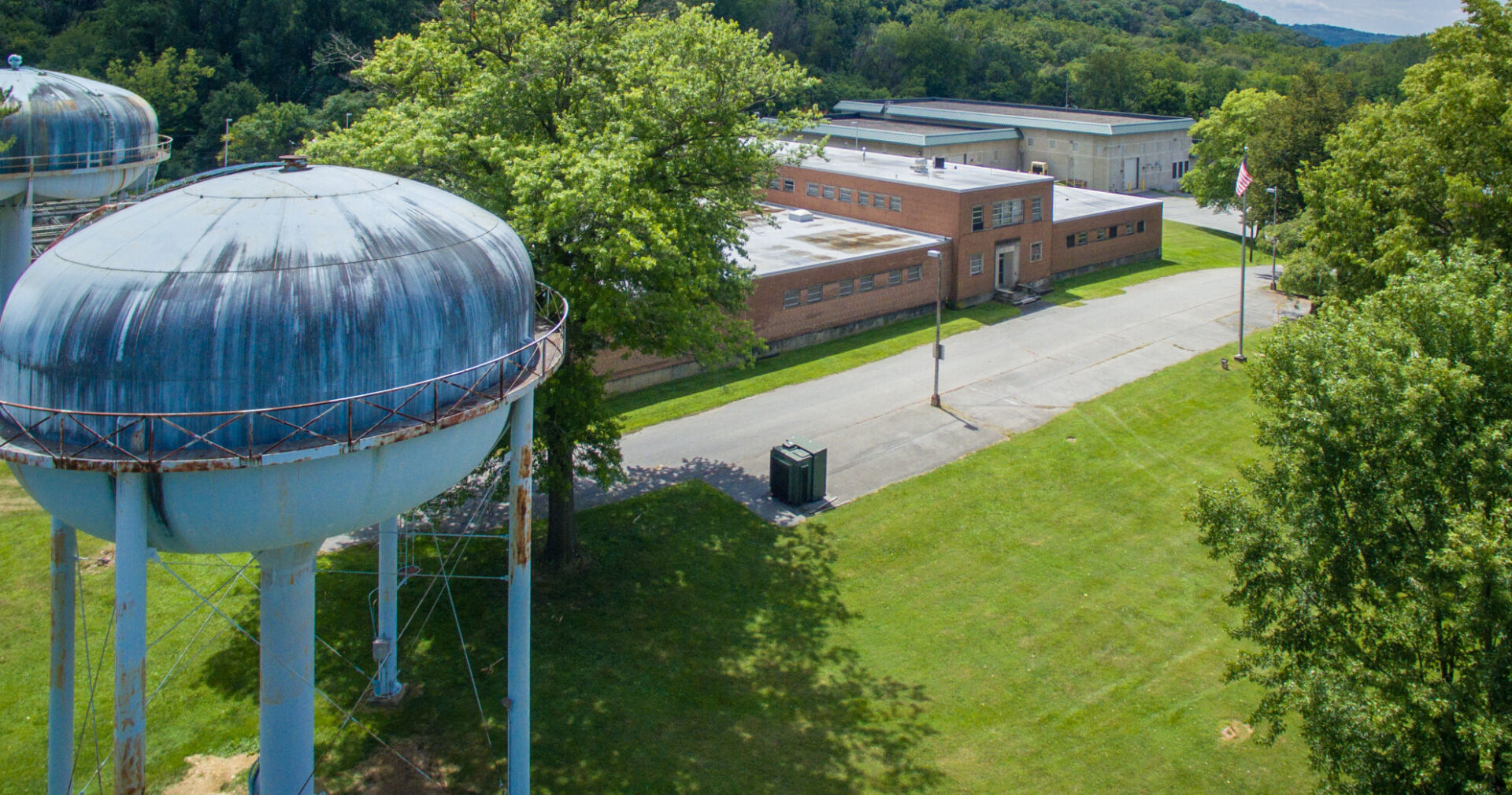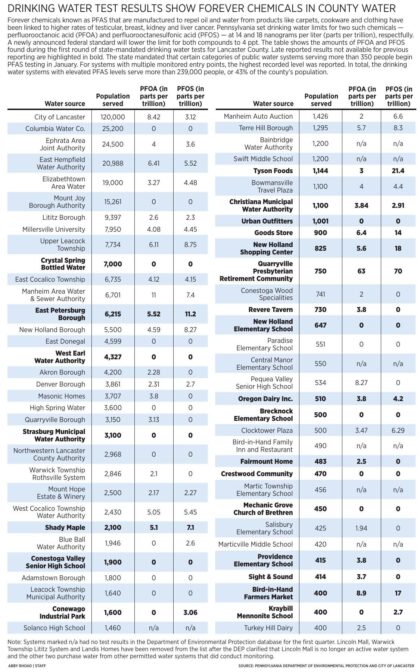
This is the Susquehanna Water Treatment Plant 900 S. 15th St. in West Hempfield Township Tuesday, Aug. 8, 2023.
Blaine Shahan / LNP | LancasterOnline

This is the Susquehanna Water Treatment Plant 900 S. 15th St. in West Hempfield Township Tuesday, Aug. 8, 2023.
Blaine Shahan / LNP | LancasterOnline

Blaine Shahan / LNP | LancasterOnline
This is the Susquehanna Water Treatment Plant 900 S. 15th St. in West Hempfield Township Tuesday, Aug. 8, 2023.
Twenty-three of Lancaster County’s 65 monitored drinking water systems tested at or above the federal contaminant limit for forever chemicals, known as PFAS, and could be facing millions in upgrade fees as they seek to improve their ability to filter out the cancer-linked compounds.
The federal limits, announced in April, are much stricter than Pennsylvania’s current state standards and will be fully enforceable in 2029, leaving drinking water systems that serve nearly 239,000 Lancaster County residents, or 43% of the county’s population, with a ticking clock to determine the cost and scope of required upgrades to their treatment systems.
The number of Lancaster County drinking water systems reporting PFAS levels at or above the federal limits has grown from 15 to 23 compared to previous LNP | LancasterOnline reporting, after 24 additional systems reported their first quarterly results late.
The Department of Environmental Protection is assessing appropriate enforcement action for the seven systems that did not report first quarter results. Three systems were removed from the originally reported list of 68: Lincoln Mall is no longer an active water system and both Warwick Township Lititz System and Landis Homes are purchasing water from other permitted water systems that did conduct monitoring.

LNP|LancasterOnline
DRINKING WATER TEST RESULTS SHOW FOREVER CHEMICALS IN COUNTY WATER ABBY RHOAD | STAFF SOURCE: PENNSYLVANIA DEPARTMENT OF ENVIRONMENTAL PROTECTION AND CITY OF LANCASTER
Manheim Area Water & Sewer Authority, which serves 6,701 residents in Manheim Borough, and Penn and Rapho townships, reported the most concrete plans to address the issue, with PFAS treatment forming a key part of the design discussions for its new water treatment plant.
The implementation timeframe laid out by the U.S. Environmental Protection Agency coincides with the four-to-five-year timeline for the authority’s new plant, said Charlie Heisey, manager for the Manheim Area Water & Sewer Authority.
The authority is working with the Pennsylvania Department of Environmental Protection on design plans, Heisey said, adding that the new federal guidelines have slowed the process down as the state determines next steps for the required pilot testing phase of the project.
The new Manheim Area Water & Sewer Authority plant will be located at 270 W. Colebrook St. in Manheim Borough, and current plans incorporate an ion-membrane filter. The latest construction cost estimate, including the new filter system, is approximately $7.5 million.
Nearly all of the drinking water systems the Watchdog contacted said they are in wait-and-see mode to determine what additional water treatments might be necessary to install, as state-mandated quarterly testing began in January. Public and community water systems serving more than 350 people are required to report results to the DEP.
Nicknamed forever chemicals because of how slowly they break down over time, PFAS are man-made chemicals manufactured to repel oil and water. PFAS is an abbreviation for perfluoroalkyl and polyfluoroalkyl substances. Common uses include carpet and furniture treatments, waterproof clothing, nonstick cookware and firefighting foam.
Pennsylvania’s regulations focus on two PFAS: perfluorooctanoic acid (PFOA) and perfluorooctanesulfonic acid (PFOS) for which the U.S. Environmental Protection Agency has determined that there is no safe level as these chemicals are linked to cancer, reduced immune response and liver damage.
The state set maximum contaminant levels of 14 parts per trillion for PFOA and 18 for PFOS, while the federal limit is set at 4 ppt for both compounds.
One part per trillion is equivalent to a single drop of PFAS in a water volume equal to 20 Olympic-sized swimming pools.
According to Pennsylvania’s current regulations, water systems that show elevated levels after the first year of quarterly monitoring must complete follow-up testing every three months and take corrective actions if elevated PFAS levels persist.
The federal rule requires initial monitoring by 2027 and gives water systems until 2029 to address out-of-compliance PFAS levels.
“The DEP will follow the Commonwealth’s rulemaking process in order to revise its regulations to address discrepancies where the state rule is less stringent,” DEP spokesperson John Repetz said in an email.
There are two Lancaster County drinking water systems that exceed the current Pennsylvania maximum contaminant PFAS standards: the Tysons Foods facility in Earl Township, which serves 1,144 people, and the Quarryville Presbyterian Retirement Community in East Drumore Township, which serves 750 people.
Tyson’s first quarterly test results were under both state and federal limits for PFOA, but its PFOS result came in at 21.4 ppt (the state limit is 18 ppt).
Tyson Foods needs to continue doing quarterly monitoring until it exceeds the rolling annual average and needs treatment, Repetz said in an email.
“Tyson Foods does not manufacture PFAS, but as a drinking water provider we are working actively to maintain ongoing compliance with all existing and emerging local, state, and federal rules and regulations, including PFAS-related policies,” a company spokesperson said in an email. “All providers of drinking water, not just Tyson Foods, must meet these new standards.”
The Quarryville Presbyterian Retirement Community reported by far the highest PFAS results in the county, with a PFOA result of 63 ppt (the state limit is 14 ppt) and a PFOS result of 70 ppt (the state limit is 18 ppt).
“The retirement home did directly sample the wells as part of its follow-up and found PFAS at the same levels,” Repetz said in an email. “The home has opted to do Public Notification at this time, and has begun to explore possible treatment options.”
The Quarryville Presbyterian Retirement Community is aware of its PFAS levels, marketing and communications director Karen Dickerson said in an email.
“QPRC is currently working with DEP and other water professionals to better understand the appropriate path forward,” Dickerson said.
PFAS-Exchange, a research initiative funded by the National Institute of Environmental Health Sciences, advises consumers to take the following steps to reduce exposure to perfluoroalkyl and polyfluoroalkyl substances, known as PFAS:
Use an activated carbon or reverse osmosis filtration system for your drinking water.
Use cast iron, stainless steel, glass or enamel cookware instead of Teflon or other nonstick products.
Use nylon or silk dental floss that is uncoated or coated in natural wax rather than glide floss.
Avoid microwave popcorn, greasy foods wrapped in paper and take-out containers.
Avoid stain-resistant carpets and upholstery and don’t use stain-resistant treatments or waterproofing sprays on carpets or furniture.
Avoid personal care or beauty products with the ingredient PTFE or other “fluoro” ingredients.
Municipalities around the country are reporting upgrade costs in the millions as they build or renovate water treatment centers designed to combat PFAS levels.
Pennsylvania and Massachusetts are among the 11 states that set maximum contaminant levels for PFAS in drinking water, according to the national environmental watchdog group Safer States, established in 2005 to advocate for regulation of toxic chemicals.
A few case studies from Massachusetts provide models for what Pennsylvania communities might be facing as they consider PFAS treatment options.
Easton, Massachusetts, a town of 25,000, paid $11 million for the construction of three plants that use an ion-exchange resin filter to treat PFAS contamination. The capital funding was approved in May 2021 and the filter plants came online in December 2023.
Westford, Massachusetts estimates it will spend between $25 million and $30 million for two PFAS treatment systems that will serve nearly 25,000 residents, as reported by Mark Warren, superintendent of the Westford Water Department, in a July 2023 public webinar.
Pennsylvania communities with experience treating PFAS report that technology has improved.
Warminster, a township of 33,000 in Bucks County, spent nearly $3 million for upgraded filter systems that use granular activated charcoal and ion-exchange resin to target PFAS contamination in 2019. At the time, upgrading the township’s entire system was estimated to cost $12 million.
“If we were today to build treatment systems, we could downsize or potentially eliminate large treatment buildings and downsize the treatment system as well,” Warminster Municipal Authority General Manager Tim Hagey said in an email. “For our system, we probably could purchase treatment systems for approximately half of the previous cost.”
Hagey emphasized that ion exchange is more cost effective and efficient at removing PFAS and that granular activated charcoal systems require a much larger building footprint.
“My experience is – do whatever is needed for ion exchange to be approved,” Hagey said.
Filter options vary widely, from activated carbon filters designed for water pitchers to whole-home reverse osmosis systems installed in main water lines. PFAS-Exchange, a research initiative funded by the National Institute of Environmental Health Sciences, recommends products that meet the NSF/ANSI 53 standard for activated carbon filters and the NSF/ANSI 58 standard for reverse osmosis systems.
For example, at cyclopure.com you can order a $45 filter cartridge designed for use with Brita pitchers or whole-home filter systems that range from $200 to $800.
The nonprofit Environmental Working Group tested a range of activated carbon or solid carbon block filters, and their tester favorite was the $70 Epic Pure Filter, estimated to last 75 days. See their full consumer guide at lanc.news/ewgfilters.

Sometimes, your mornings are just too busy to catch the news beyond a headline or two. Don’t worry. The Morning Agenda has got your back. Each weekday morning, host Tim Lambert will keep you informed, amused, enlightened and up-to-date on what’s happening in central Pennsylvania and the rest of this great commonwealth.
The days of journalism’s one-way street of simply producing stories for the public have long been over. Now, it’s time to find better ways to interact with you and ensure we meet your high standards of what a credible media organization should be.